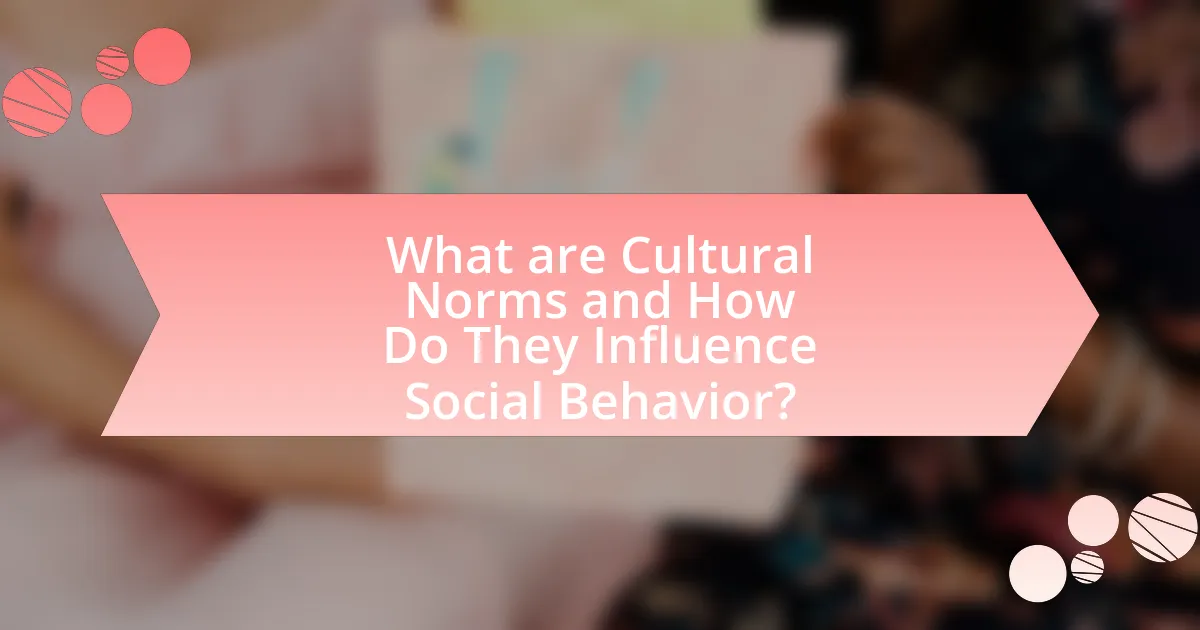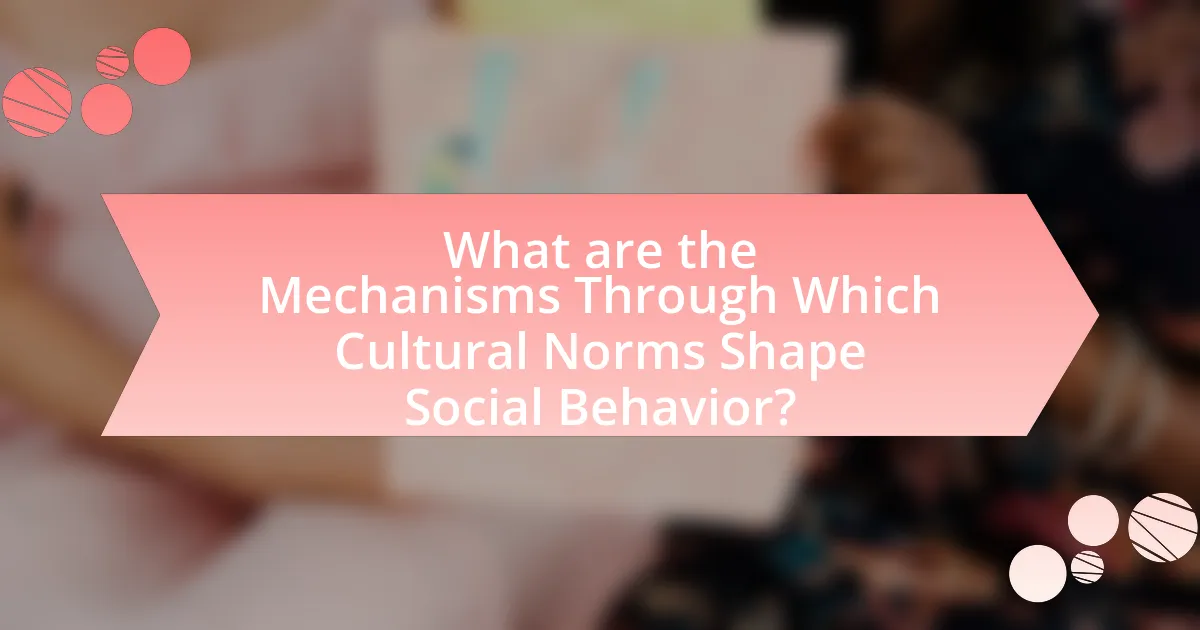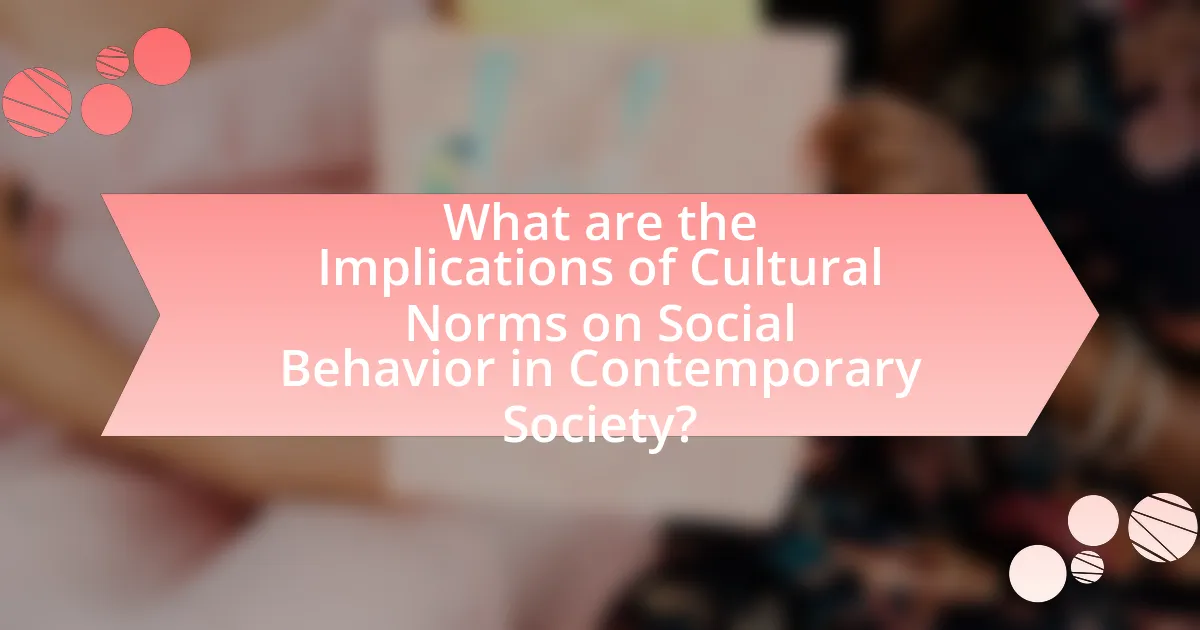Cultural norms are the shared expectations and rules that guide behavior within specific groups or societies, significantly influencing social behavior and interpersonal relationships. This article explores how cultural norms are defined across different societies, the role of values and beliefs in shaping these norms, and their impact on social cohesion, communication, and group identity. It examines the mechanisms through which cultural norms affect individual behavior, the evolution of these norms over time, and their implications for contemporary social issues such as gender roles and diversity. Additionally, the article discusses practical strategies for navigating cultural norms in social interactions, emphasizing the importance of cultural awareness and adaptability.

What are Cultural Norms and How Do They Influence Social Behavior?
Cultural norms are the shared expectations and rules that guide behavior within a specific group or society. These norms influence social behavior by establishing standards for acceptable conduct, shaping individuals’ actions, and fostering a sense of belonging. For instance, in collectivist cultures, norms emphasize group harmony and cooperation, leading individuals to prioritize community needs over personal desires. Conversely, in individualistic cultures, norms encourage self-expression and personal achievement, which can result in more competitive social interactions. Research indicates that adherence to cultural norms can significantly affect social cohesion and interpersonal relationships, as individuals often modify their behavior to align with the expectations of their cultural context.
How are cultural norms defined in different societies?
Cultural norms are defined in different societies as the shared expectations and rules that guide behavior within those societies. These norms vary significantly based on factors such as geography, history, religion, and social structures. For instance, in collectivist societies like Japan, cultural norms emphasize group harmony and consensus, while in individualistic societies like the United States, personal freedom and self-expression are prioritized. Research by Geert Hofstede highlights these differences, showing that cultural dimensions such as individualism versus collectivism shape societal norms and influence social behavior.
What role do values and beliefs play in shaping cultural norms?
Values and beliefs are fundamental in shaping cultural norms as they provide the underlying principles that guide behavior and social expectations within a community. These values and beliefs influence what is considered acceptable or unacceptable, thereby establishing the framework for cultural norms. For instance, in societies that prioritize individualism, such as the United States, cultural norms often emphasize personal freedom and self-expression, reflecting the belief in individual rights. Conversely, collectivist cultures, like Japan, promote norms that prioritize group harmony and social cohesion, rooted in the belief that the group’s well-being is paramount. This relationship between values, beliefs, and cultural norms is evident in various sociological studies, such as Geert Hofstede’s cultural dimensions theory, which illustrates how different cultural values lead to distinct behavioral norms across societies.
How do cultural norms vary across different regions and communities?
Cultural norms vary significantly across different regions and communities, influencing behaviors, values, and social interactions. For instance, collectivist cultures, such as those in many Asian countries, prioritize group harmony and familial obligations, while individualistic cultures, like those in the United States, emphasize personal freedom and self-expression. Research by Hofstede identifies six dimensions of culture, including individualism versus collectivism, which illustrates these differences. Furthermore, norms surrounding gender roles, communication styles, and social etiquette can differ widely; for example, in Scandinavian countries, gender equality is a strong cultural norm, whereas in some Middle Eastern cultures, traditional gender roles are more pronounced. These variations highlight how cultural context shapes social behavior and interpersonal relationships.
Why are cultural norms important for social cohesion?
Cultural norms are important for social cohesion because they establish shared expectations and behaviors that facilitate cooperation and understanding among individuals within a community. These norms create a sense of belonging and identity, which strengthens interpersonal relationships and promotes social stability. For instance, research by the Pew Research Center indicates that communities with strong cultural norms experience lower levels of conflict and higher levels of trust among members, leading to enhanced social cohesion.
How do cultural norms facilitate communication and understanding among individuals?
Cultural norms facilitate communication and understanding among individuals by providing a shared framework of expectations and behaviors. These norms guide how individuals interpret messages, respond to social cues, and engage in dialogue, thereby reducing misunderstandings. For instance, in collectivist cultures, emphasis on group harmony influences communication styles, encouraging indirect expression and consensus-building, which fosters deeper understanding. Research by Hofstede (1980) highlights that cultural dimensions, such as individualism versus collectivism, significantly affect interpersonal interactions, illustrating how cultural norms shape communication patterns and enhance mutual comprehension.
What impact do cultural norms have on group identity and belonging?
Cultural norms significantly shape group identity and belonging by establishing shared values, behaviors, and expectations among members. These norms create a sense of cohesion and unity, as individuals align their actions and beliefs with those of the group, fostering a collective identity. For instance, research by Triandis (1995) highlights that in collectivist cultures, individuals prioritize group goals over personal ambitions, reinforcing a strong sense of belonging and identity within the group. Additionally, cultural norms dictate acceptable behaviors, which can enhance group solidarity and discourage deviations that may threaten group cohesion. This dynamic illustrates how cultural norms are fundamental in defining group identity and facilitating a sense of belonging among its members.
How do cultural norms affect individual behavior in social settings?
Cultural norms significantly shape individual behavior in social settings by establishing expectations for conduct and interaction. These norms dictate acceptable behaviors, influencing how individuals communicate, express emotions, and engage with others. For example, in collectivist cultures, such as Japan, individuals may prioritize group harmony and consensus, leading to more reserved and indirect communication styles. Conversely, in individualistic cultures like the United States, assertiveness and self-expression are often encouraged, resulting in more direct interactions. Research by Hofstede (1980) highlights these differences, showing that cultural dimensions such as individualism versus collectivism directly impact social behavior patterns across various societies.
What are examples of behaviors influenced by cultural norms?
Examples of behaviors influenced by cultural norms include greetings, dining etiquette, and dress codes. In many Western cultures, a common greeting is a handshake, while in some Asian cultures, bowing is preferred, reflecting respect and hierarchy. Dining etiquette varies significantly; for instance, in Japan, it is customary to say “itadakimasu” before meals, while in Italy, sharing food from a communal plate is common, showcasing a sense of community. Dress codes also differ; in conservative cultures, modest clothing is expected, whereas more liberal societies may embrace casual attire. These behaviors illustrate how cultural norms shape social interactions and expectations.
How do cultural norms dictate acceptable social interactions?
Cultural norms dictate acceptable social interactions by establishing shared expectations and behaviors within a community. These norms influence how individuals communicate, express emotions, and engage in relationships, thereby shaping social dynamics. For example, in collectivist cultures, such as Japan, norms emphasize group harmony and indirect communication, leading individuals to prioritize consensus and avoid confrontation. Conversely, in individualistic cultures like the United States, norms encourage direct communication and self-expression, allowing for more open discussions. Research by Hofstede (1980) highlights these differences, demonstrating how cultural dimensions impact interpersonal interactions and social behavior across various societies.

What are the Mechanisms Through Which Cultural Norms Shape Social Behavior?
Cultural norms shape social behavior through mechanisms such as socialization, conformity, and reinforcement. Socialization occurs when individuals learn and internalize the values and behaviors expected by their culture, influencing their actions and interactions. Conformity involves individuals adjusting their behaviors to align with group norms, often driven by the desire for acceptance or fear of rejection. Reinforcement occurs when behaviors that align with cultural norms are rewarded, while those that deviate are punished, thereby encouraging adherence to these norms. Research by Cialdini and Goldstein (2004) in “Social Influence: Compliance and Conformity” illustrates how these mechanisms operate in various social contexts, demonstrating their significant impact on individual behavior.
How do socialization processes reinforce cultural norms?
Socialization processes reinforce cultural norms by instilling shared values and behaviors through various agents such as family, education, and media. These agents actively transmit cultural expectations, shaping individuals’ understanding of acceptable conduct within their society. For example, children learn societal norms through parental guidance and peer interactions, which teach them what is considered appropriate or inappropriate behavior. Research indicates that consistent reinforcement of these norms leads to conformity, as individuals seek acceptance and approval from their social groups. This dynamic is evident in studies showing that individuals who deviate from cultural norms often face social sanctions, further solidifying the importance of socialization in maintaining cultural standards.
What role do family and education play in the transmission of cultural norms?
Family and education play a crucial role in the transmission of cultural norms by serving as primary agents of socialization. Families instill values, beliefs, and practices in children from an early age, shaping their understanding of acceptable behavior within their culture. For example, research indicates that children learn cultural norms through observation and imitation of family members, which is supported by Bandura’s Social Learning Theory, highlighting the importance of role models in the learning process.
Education further reinforces these cultural norms by providing structured environments where societal values are taught explicitly through curricula and implicitly through peer interactions. Schools often promote cultural norms such as respect, cooperation, and discipline, which are essential for social cohesion. A study by the National Center for Education Statistics shows that educational institutions significantly influence students’ social behaviors and attitudes, thereby perpetuating cultural norms across generations.
How do peer groups influence adherence to cultural norms?
Peer groups significantly influence adherence to cultural norms by providing social reinforcement and establishing expectations for behavior. Individuals often conform to the norms upheld by their peer groups to gain acceptance and avoid social rejection. Research indicates that adolescents, for example, are particularly susceptible to peer influence, as demonstrated in a study by Steinberg and Monahan (2007), which found that peer presence increases risk-taking behaviors, highlighting the power of peer dynamics in shaping cultural adherence. This social pressure can lead to the internalization of cultural norms, as individuals align their behaviors with those of their peers to maintain group cohesion and identity.
What psychological factors contribute to the influence of cultural norms on behavior?
Psychological factors that contribute to the influence of cultural norms on behavior include socialization, conformity, and cognitive dissonance. Socialization processes instill cultural norms from an early age, shaping individual behaviors to align with societal expectations. Conformity, as demonstrated in Solomon Asch’s experiments, shows that individuals often adjust their behaviors to match group norms, highlighting the power of social influence. Cognitive dissonance, identified by Leon Festinger, occurs when individuals experience discomfort from conflicting beliefs and behaviors, leading them to change their actions to align with cultural norms. These factors collectively illustrate how deeply ingrained cultural norms can shape individual behavior through psychological mechanisms.
How do conformity and obedience relate to cultural norms?
Conformity and obedience are closely related to cultural norms as they both reflect the influence of societal expectations on individual behavior. Conformity occurs when individuals adjust their attitudes or behaviors to align with group norms, while obedience involves following direct commands or instructions from authority figures, often shaped by cultural context. Research by Asch (1951) demonstrated that individuals are likely to conform to group opinions even when they contradict their own beliefs, highlighting the power of cultural norms in shaping perceptions of correctness. Similarly, Milgram’s experiments (1963) illustrated that people often obey authority figures, even when such obedience conflicts with personal morals, underscoring how cultural norms dictate the acceptance of authority. Thus, both conformity and obedience serve as mechanisms through which cultural norms exert influence over social behavior.
What is the impact of social pressure on individual behavior?
Social pressure significantly influences individual behavior by compelling individuals to conform to group norms and expectations. This phenomenon is evident in various social contexts, where individuals may alter their actions, beliefs, or attitudes to align with those of their peers. Research by Asch (1951) demonstrated that individuals often conform to group opinions even when they contradict their own perceptions, highlighting the power of social pressure in shaping behavior. Additionally, studies indicate that social pressure can lead to both positive outcomes, such as increased cooperation, and negative consequences, such as the perpetuation of harmful behaviors, illustrating its complex impact on individual decision-making.
How do cultural norms evolve over time and affect social behavior?
Cultural norms evolve over time through processes such as socialization, globalization, and technological advancements, which collectively shape social behavior. For instance, the rise of digital communication has transformed norms around privacy and interpersonal interactions, leading to more informal and immediate forms of communication. Historical examples include the shift in attitudes toward gender roles, where movements for gender equality have redefined expectations and behaviors in both professional and domestic spheres. Research indicates that as societies become more interconnected, cultural norms can shift rapidly, influencing behaviors such as consumerism and social responsibility, as seen in the increasing emphasis on sustainability in response to climate change awareness.
What factors contribute to the change of cultural norms within a society?
Factors that contribute to the change of cultural norms within a society include technological advancements, globalization, social movements, and demographic shifts. Technological advancements, such as the internet and social media, facilitate the rapid dissemination of ideas and values, leading to shifts in societal expectations and behaviors. Globalization exposes societies to diverse cultures, prompting the adoption of new norms and practices. Social movements, like civil rights and environmental activism, challenge existing norms and advocate for change, influencing public perception and policy. Demographic shifts, including migration and changes in population composition, also play a crucial role by introducing new cultural perspectives and practices that can reshape societal norms.
How does globalization impact local cultural norms and behaviors?
Globalization significantly alters local cultural norms and behaviors by facilitating the exchange of ideas, values, and practices across borders. This process often leads to the homogenization of cultures, where local traditions may be overshadowed by dominant global influences, such as Western consumer culture. For instance, the proliferation of global brands and media can shift local consumption patterns and social interactions, as seen in countries where traditional customs are replaced by Western-style shopping and entertainment practices. Research indicates that in many developing nations, exposure to global media has resulted in changing gender roles and family structures, reflecting a shift towards more individualistic values. This evidence underscores the profound impact of globalization on local cultural frameworks, reshaping identities and social behaviors in the process.

What are the Implications of Cultural Norms on Social Behavior in Contemporary Society?
Cultural norms significantly shape social behavior in contemporary society by establishing expectations for how individuals interact and communicate. These norms dictate acceptable behaviors, influencing everything from personal relationships to workplace dynamics. For instance, in collectivist cultures, individuals often prioritize group harmony over personal expression, leading to behaviors that emphasize cooperation and consensus. Conversely, in individualistic cultures, personal achievement and self-expression are valued, resulting in more assertive social interactions. Research by Hofstede (1980) on cultural dimensions illustrates these differences, showing that cultural context can lead to varying social behaviors across societies. Thus, cultural norms serve as a framework that guides social interactions, impacting everything from etiquette to conflict resolution.
How do cultural norms influence social issues such as gender roles and equality?
Cultural norms significantly shape social issues like gender roles and equality by establishing expectations and behaviors deemed acceptable within a society. These norms dictate how individuals should act based on their gender, often leading to rigid roles that limit opportunities for both men and women. For instance, in many cultures, traditional norms may promote the idea that men should be the primary breadwinners, while women are expected to take on caregiving roles, which can perpetuate economic disparities and limit women’s access to leadership positions. Research by the World Economic Forum indicates that countries with more progressive cultural norms regarding gender equality tend to have smaller gender gaps in economic participation and opportunity, highlighting the direct impact of cultural perceptions on social structures.
What are the cultural norms surrounding gender in different societies?
Cultural norms surrounding gender vary significantly across different societies, influencing roles, behaviors, and expectations. For instance, in many Western societies, gender norms have evolved towards greater equality, promoting shared responsibilities in both domestic and professional spheres. In contrast, traditional societies, such as those in parts of the Middle East and South Asia, often adhere to rigid gender roles where men are typically seen as providers and women as caretakers, reflecting historical practices and religious beliefs.
Research indicates that these norms shape individual identities and social interactions; for example, a study by Eagly and Wood (1999) in the “American Psychologist” journal highlights how societal expectations dictate gender-specific behaviors, reinforcing stereotypes. Furthermore, in Scandinavian countries, progressive gender norms have led to policies that support parental leave for both mothers and fathers, fostering a more balanced approach to gender roles. These examples illustrate how cultural norms surrounding gender are not only diverse but also deeply embedded in the social fabric of each society, affecting everything from family dynamics to workplace policies.
How do cultural norms affect perceptions of gender equality?
Cultural norms significantly shape perceptions of gender equality by establishing societal expectations regarding gender roles. These norms dictate behaviors, responsibilities, and opportunities available to different genders, often leading to unequal treatment. For instance, in many cultures, traditional norms prioritize male authority and female submissiveness, which can perpetuate gender disparities in areas such as employment, education, and political representation. Research by the World Economic Forum indicates that countries with more progressive cultural norms regarding gender roles tend to have higher levels of gender equality, as evidenced by their rankings in the Global Gender Gap Index. This correlation highlights how cultural perceptions directly influence the realization of gender equality in various societies.
What role do cultural norms play in shaping attitudes towards diversity and inclusion?
Cultural norms significantly influence attitudes towards diversity and inclusion by establishing the accepted behaviors and values within a society. These norms dictate how individuals perceive and interact with differences in race, gender, sexual orientation, and other identity markers. For instance, societies that prioritize collectivism may foster a greater acceptance of diversity as a means of social harmony, while those emphasizing individualism might focus on meritocracy, potentially leading to exclusionary practices. Research indicates that countries with inclusive cultural norms, such as those found in Scandinavia, report higher levels of social cohesion and acceptance of diverse populations, as evidenced by studies from the World Values Survey. This demonstrates that cultural norms are foundational in shaping societal attitudes, either promoting inclusivity or reinforcing biases.
How do cultural norms impact the acceptance of different lifestyles and identities?
Cultural norms significantly influence the acceptance of different lifestyles and identities by establishing societal standards that dictate what is considered acceptable behavior. These norms shape perceptions and attitudes towards diversity, often leading to either inclusion or exclusion based on conformity to established values. For instance, in societies with rigid gender roles, individuals who identify outside these norms may face discrimination, while more progressive cultures may embrace diverse identities, as evidenced by the increasing visibility and acceptance of communities in many Western countries. Research indicates that societies with higher levels of cultural openness tend to exhibit greater acceptance of varied lifestyles, as seen in studies by Pew Research Center, which highlight the correlation between cultural attitudes and social acceptance.
What challenges arise from conflicting cultural norms in multicultural societies?
Conflicting cultural norms in multicultural societies lead to challenges such as social tension, miscommunication, and discrimination. These challenges arise because individuals from different cultural backgrounds may have divergent values, beliefs, and practices, which can result in misunderstandings and conflicts. For instance, a study by the Pew Research Center found that 60% of people in multicultural societies report experiencing tension due to differing cultural expectations. This tension can manifest in various forms, including workplace conflicts, community divisions, and increased prejudice, ultimately hindering social cohesion and integration.
What practical strategies can individuals use to navigate cultural norms in social interactions?
Individuals can navigate cultural norms in social interactions by employing strategies such as active observation, cultural education, and adaptive communication. Active observation involves paying close attention to the behaviors and reactions of others within a specific cultural context, allowing individuals to identify and understand the prevailing norms. Cultural education, which can include reading about different cultures or engaging in cultural exchange programs, equips individuals with knowledge about various customs and practices, fostering respect and understanding. Adaptive communication entails adjusting one’s language, tone, and body language to align with the cultural expectations of the group, thereby enhancing rapport and reducing misunderstandings. These strategies are supported by research indicating that cultural competence significantly improves interpersonal relationships and reduces conflict in diverse settings.
How can awareness of cultural norms improve interpersonal communication?
Awareness of cultural norms can significantly improve interpersonal communication by fostering understanding and reducing misunderstandings between individuals from different backgrounds. When individuals recognize and respect cultural norms, they can tailor their communication styles to align with the expectations and values of others, which enhances clarity and rapport. For instance, research by Gudykunst and Kim in “Communicating with Strangers” highlights that effective intercultural communication is rooted in understanding the cultural context, which can lead to more meaningful interactions and less conflict. This understanding allows individuals to navigate social cues, body language, and conversational styles that vary across cultures, ultimately leading to more effective and harmonious exchanges.
What best practices can help individuals respect and adapt to diverse cultural norms?
To respect and adapt to diverse cultural norms, individuals should engage in active listening and open-mindedness. Active listening allows individuals to fully understand different perspectives, fostering empathy and respect for cultural differences. Open-mindedness encourages individuals to challenge their own biases and preconceptions, which is essential for effective cross-cultural interactions.
Research indicates that cultural intelligence, which encompasses knowledge, mindfulness, and behavioral skills, significantly enhances one’s ability to navigate diverse cultural settings (Ang et al., 2007). By developing cultural intelligence, individuals can better appreciate and adapt to the nuances of various cultural norms, leading to more harmonious social interactions.
